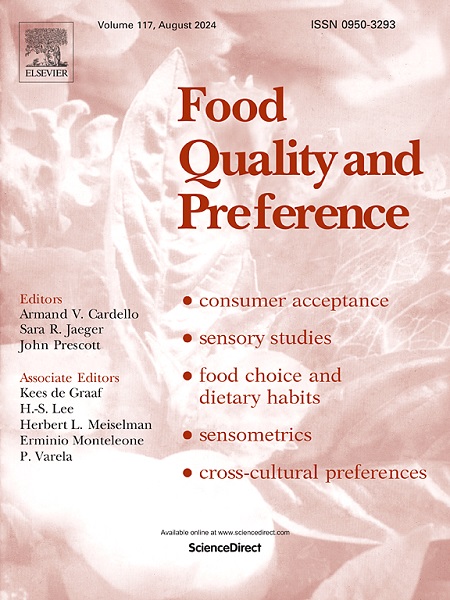旧的,新的,还是借来的——熟悉度和跨文化食谱整合在喜欢和选择鱼产品中的作用
IF 4.9
1区 农林科学
Q1 FOOD SCIENCE & TECHNOLOGY
引用次数: 0
摘要
饮食文化在吸收新影响的同时保留其起源的某些方面,从而不断发展。将文化的影响与传统食物相结合,产生了具有熟悉和异国情调元素的新菜系。在这项研究中,我们的目标是寻求其他以鱼为中心的文化的影响,以开发融合当地鱼类和国际风味的菜肴。在子研究I中,在消费者感官评价(n = 100)中,将商业鱼产品的愉悦度和熟悉度与开发的原型进行比较。在子研究II中,其中一种原型被用作开发新菜的原料,其中包含来自巴斯克、西班牙、加泰罗尼亚、意大利和墨西哥饮食文化的元素,以及传统的芬兰原料。在多感官用餐环境下,对新菜肴进行了两次重复的消费者感官评估(n = 93)。子研究1表明,随着人们对某些鱼类产品的熟悉程度的增加,人们对它们的喜爱程度也会增加。这在商业腌鲱鱼和原型腌鲱鱼中尤为明显;在经常食用传统腌鱼的人群中,他们的愉悦感更高。在新菜的子研究II中,Nachos在第一和第二感官评估中获得了最高的总体喜欢度(平均得分分别为6.38和6.42,满分为7分)。研究还发现,在新产品的情况下,消费者更依赖于外观和印象,而对于熟悉的产品,消费者的选择更基于感官知觉。此外,通过将传统但如今不太受欢迎的食材与全球饮食文化的元素相结合,我们能够开发出受欢迎的产品。本文章由计算机程序翻译,如有差异,请以英文原文为准。
Old, new, or borrowed – the role of familiarity and cross-cultural recipe integration in the liking and choices of fish products
Food cultures evolve as they absorb new influences while retaining aspects of their origins. Blending cultural influences with traditional foods gives rise to new cuisines with familiar and exotic elements. In this study, we aimed to seek influence from other fish-centric cultures to develop dishes that blended local fish with international flavors.
In Sub-study I, the pleasantness and familiarity of commercial fish products were compared with developed prototypes in a consumer sensory evaluation (n = 100). In Sub-study II, one of the prototypes was used as an ingredient in developing new dishes with elements from Basque, Spanish, Catalan, Italian, and Mexican food cultures, with a traditional Finnish ingredient. A twice repeated consumer sensory evaluation (n = 93) of the new dishes was conducted in a multisensory dining context.
The Sub-study I showed that pleasantness of some of the fish products increased with increasing familiarity. This was seen especially in the case of commercial and prototype pickled Baltic herring; their pleasantness was higher among the frequent users of traditional pickled fish. In Sub-study II of the new dishes Nachos had the highest overall liking in the first and second sensory evaluation (mean scores 6.38 and 6.42 out of 7, respectively). It was also found that in the case of new products, consumers relied on appearance and impression, whereas with familiar products, choice was based rather on sensory perception. Moreover, we were able to develop liked products by combining a traditional but nowadays less popular ingredient with elements from global food cultures.
求助全文
通过发布文献求助,成功后即可免费获取论文全文。
去求助
来源期刊

Food Quality and Preference
工程技术-食品科技
CiteScore
10.40
自引率
15.10%
发文量
263
审稿时长
38 days
期刊介绍:
Food Quality and Preference is a journal devoted to sensory, consumer and behavioural research in food and non-food products. It publishes original research, critical reviews, and short communications in sensory and consumer science, and sensometrics. In addition, the journal publishes special invited issues on important timely topics and from relevant conferences. These are aimed at bridging the gap between research and application, bringing together authors and readers in consumer and market research, sensory science, sensometrics and sensory evaluation, nutrition and food choice, as well as food research, product development and sensory quality assurance. Submissions to Food Quality and Preference are limited to papers that include some form of human measurement; papers that are limited to physical/chemical measures or the routine application of sensory, consumer or econometric analysis will not be considered unless they specifically make a novel scientific contribution in line with the journal''s coverage as outlined below.
 求助内容:
求助内容: 应助结果提醒方式:
应助结果提醒方式:


